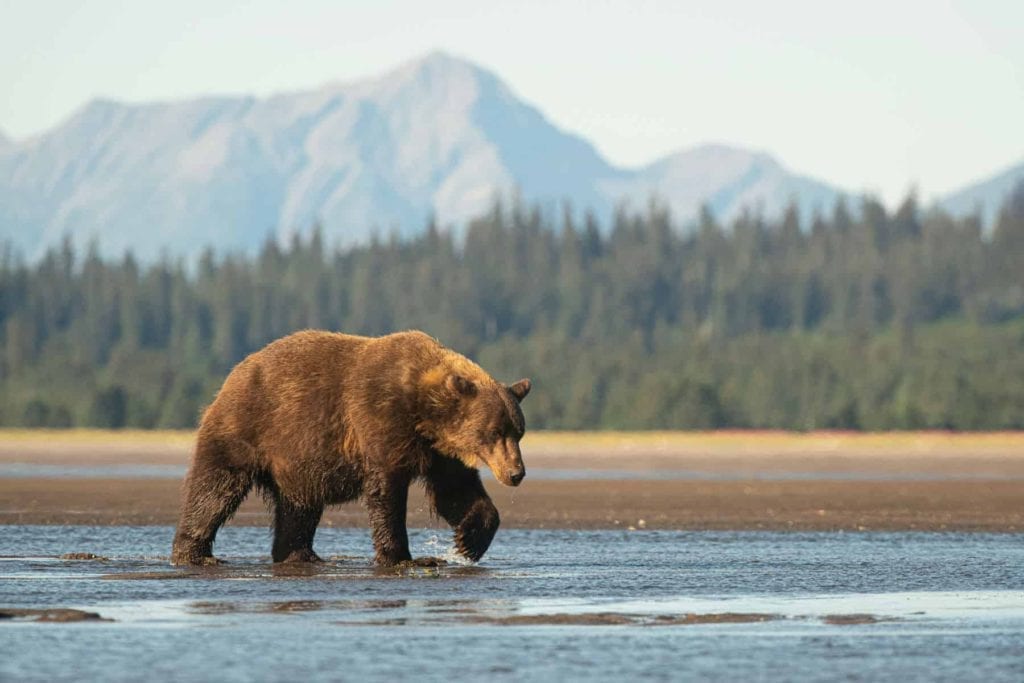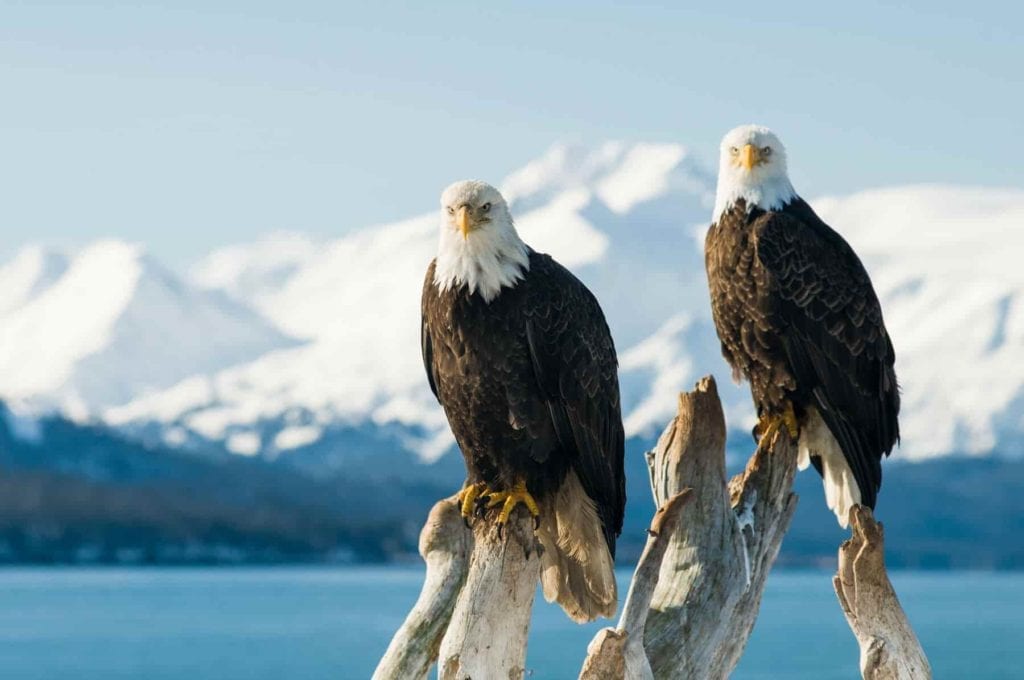This is not a normal year, of course. But that doesn’t mean you shouldn’t start mapping out your next Alaskan adventure now. In fact, with 663,000 square miles to cover, you can’t start soon enough. If it’s wildlife you’re after, this place will deliver like no other. The only question is, what do you want to see? Depending on your answer, here’s a list of where exactly to go. And even though it might be a while before you’re actually on your way, many of these destinations maintain webcams so you can enjoy a virtual sneak peak in the interim.
Bears
Spotting a grizzly in the wild can be both exhilarating and terrifying depending on the circumstances. Either way, coming across the massive mammal while hiking the backcountry will certainly elevate your heart rate. So make sure you are well-versed in bear safety protocol, always stay calm, and remember that unprovoked bear attacks are actually quite rare. Over the past decade only four people have been killed by an Alaskan brown bear.
If you’re willing to meet them where they live, Brooks Fall in Katmai National Park and Preserve is where you need to be. Every July, like clockwork, hundreds of brown bears trek here to a narrow section of river, drawn by an exceptionally active salmon run. A viewing platform by the cascade allows visitors to see dozens of them at a time, lined up with mouths open as if they were at a Las Vegas buffet.
“Bears habituate to people and they are highly motivated to go to streams where the salmon are running,” explains Riley Woodford, information officer for Alaska’s Department of Fish and Game. “In July and August it is pretty much guaranteed that you’re going to find them in these places.”

Getting there isn’t cheap, however. Off the road system, it requires a roundtrip excursion on a seaplane. A full day trip with Rust’s Flying Service out of Anchorage will set you back just over $1,000 person. It includes lunch, park entry fee, and one of the most scenic two hours of flying you’ll ever experience. If that’s beyond your price range, explore.org offers a virtual alternative with its webcam broadcasting live throughout the season.
For those seeking something snowier, there are a number of top-rated outfitters providing tours of polar bear country. Northern Alaska Tour Company is a standout. Throughout August and September, they’ll fly you and up to three guests from Fairbanks to the Inupiat Eskimo village of Kaktovik. It’s the only permanent settlement within the Arctic National Wildlife Refuge. From there you board a boat to encounter the maritime mammals in their native habitat, from a safe distance. The 11-hour, roundtrip excursion costs $1,989 per passenger.
Whales
If bears are the #1 wildlife draw in Alaska, whales are 1B. And if it’s the mighty humpback you’re in search of, you’ll want to head to the panhandle in the southeastern corner of the state. “In the waters surrounding Ketchikan and Sitka, they come incredibly close to the shore,” according to Woodford. “And there is great infrastructure to support whale watching.”
The sprawling ‘city’ of Sitka (pop. 8,800) is actually the country’s largest by square mileage. Owning nearly 3,000 square miles of real estate, it’s roughly six times the size of Los Angeles. Thankfully, most of the services are centered alongside the harbor, within stone’s throw of the airport by which most visitors arrive. Beeline from there directly to Gallant Adventures to book a standard 3-hour — or extended 5.5-hour — tour of the majestic Sitka Sound.
Come during the summer and it’s quite likely you’ll spy spouts, flukes, and maybe even an elusive breach. This part of the world serves as feeding ground to an estimated 10,000 humpbacks before they head to Hawaii every winter for breeding. Equally as prevalent are pods of orcas and gray whales.
Belugas, by comparison, might as well be unicorns. An isolated population of the white wonders exist around the Cook Inlet outside of Anchorage. Head south of the city to the Turnagain Arm from mid-July through August when salmon are running and perhaps you’ll get lucky enough to spot them from shore. A little later in the season, those that brave the lengthy voyage to Nome — along the western edge of the state — might catch a glimpse of them as they follow the tomcod migration down the Norton Sound.

Birds
“Seeing a bald eagle in Alaska is pretty much like seeing a seagull anywhere else,” explains Woodford. “They’re fun to watch and they’re everywhere. So you don’t have to pay money to go on a tour. We’ve actually found that wildlife viewing and birdwatching is a bigger industry than hunting here.”
He recommends heading down to Haines for the annual Bald Eagle Festival in mid-November. There you’ll find thousands of the national bird congregating in the area for an unusually late salmon run along the Chilkoot River.
Along the southwestern edge of the Kenai Peninsula, the town of Homer is another bald eagle hotspot. The 4.5-mile-long Homer Spit, jutting out into Kachemak Bay, was once home to Jean Keene — the legendary ‘Eagle Lady.’ For decades she would hold court for thousands of the birds, feeding them and turning the region into an international tourist attraction. Although edible handouts were outlawed within city limits in 2006, Keene was granted an exemption and continued providing meals to her avian friends until her passing in 2009.
Set sail across the bay and you’ll be transported to the magical confines of Halibut Cove. You’ll probably even encounter some otters along the way. The former fishing village is now a self-contained community holding a seafood restaurant, a floating post office and the Stillpoint Lodge — a luxury resort perched high atop a hill, affording prime viewing of the winged natives. Among them: whiskered auklets, red-legged kittiwakes, and McKay’s buntings.
For those favoring seabirds such as puffins and albatross, you’ll need to fly out to the Seward Peninsula. Woodford advises an excursion to the region’s primary hub of Nome sometime around June. “There’s around 300 miles of road with exceptional wildlife viewing and 24 hours of daylight,” he says. “It’s wide open country. And you’ll even see a bunch of muskox and caribou while you’re up there.”
Walrus
Fans of flippered mammals will find ample solace amidst the Aleutians. The archipelago is home to Round Island, site of the largest walrus haul-out in all of the United States. Each summer as many as 14,000 male walruses seek shelter on the rocky shoals here. You can access an elevated viewing platform — and even camp out on the island — from May 1st through August 15th. But you’ll need to secure a permit, good for up to five days, from the Alaska Department of Fish and Game office about 65 miles northeast in the town of Dillingham.
Note that this excursion takes you far from any highway system. Travel to the sanctuary requires a commercial flight from Anchorage to Dillingham, followed by a ride on a local puddle-jumper to Togiak, before a 35 minute boat taxi to the uninhabited island. If that sounds like too much of a commitment at the moment, build up your resolve by watching live webcam footage of these cuddlesome, sea dogs.
Wolves
“Wolves are a super elusive animal,” warns Woodford. “Sometimes you’ll see them in Denali National Park — packs of timberwolves and grey wolves are present there. But make no mistake: they don’t want to be seen.”
Nonetheless, with an estimated population between 8,000-10,000 throughout the state, your chances are better here than in most other places in the lower 48. Up north of the Arctic Circle, they often spend their time exposed in the tundra. But because they are so difficult to track, you won’t find any tour company setup to expressly serve their viewing. “To have an industry you need to have some sort of guarantee,” says Woodford, “And they are just too consistent for that.”
Especially rugged adventures can trudge 250 unpaved miles north of Fairbanks on the Dalton Highway to the weary way-station of Coldfoot. This ’town’ of just ten residents is well north of the Arctic Circle. A barren, often-snowy terrain stretches to the horizon in every direction, providing a stark contrast to the dark-furred wolves native to here.
But if you love a good long shot, you needn’t make it that far from civilization. You can try your luck in Juneau, instead. The outskirts of the state capital are home to roughly half a dozen wolf packs. Across these dense forests they roam in search of their preferred food source: the Sitka black-tailed deer. Maybe you’ll chance into a meeting with both predator and prey. For any wildlife enthusiast it could easily form a once-in-a-lifetime memory. In Alaska, it’s just another day in the bush.
Citation:
Japhe, Brad. “How to See Whales, Bears, Eagles and More Incredible Wildlife in Alaska.” Travel + Leisure, 14 June 2020, www.travelandleisure.com/animals/how-to-see-whales-bears-eagles-wildlife-in-alaska.
